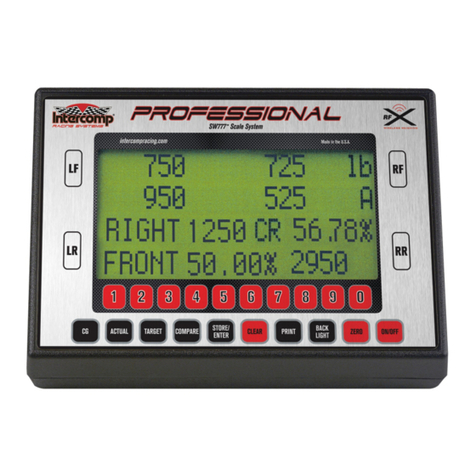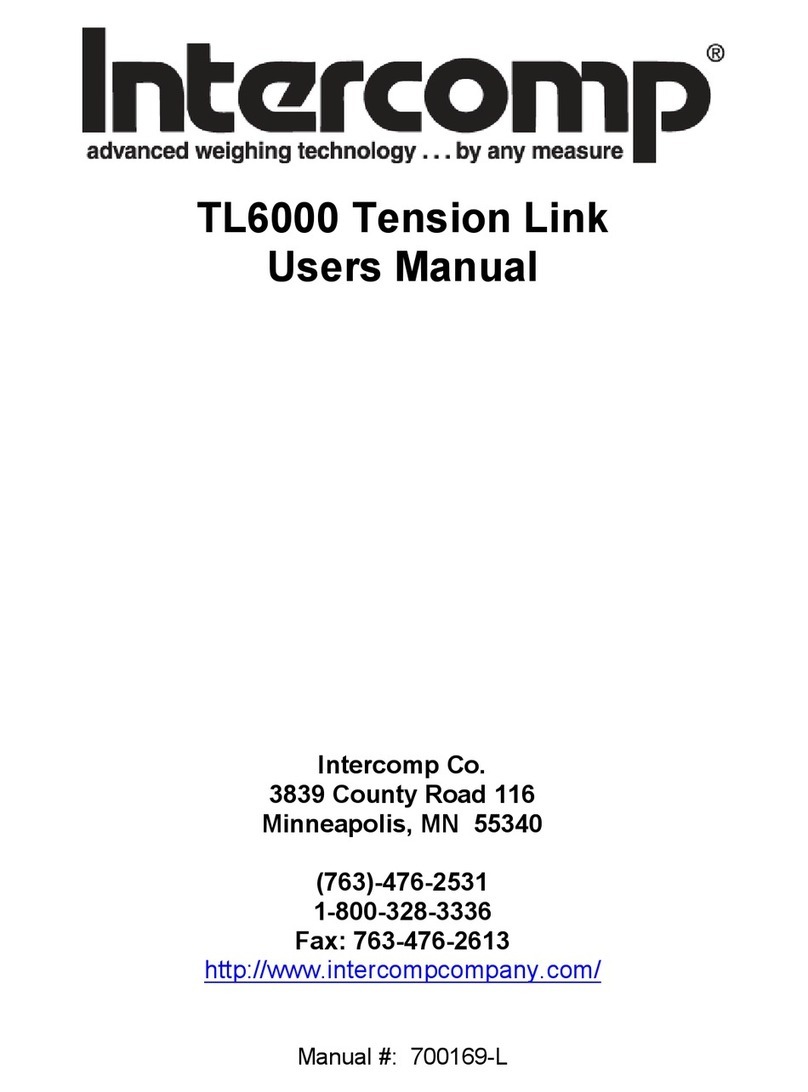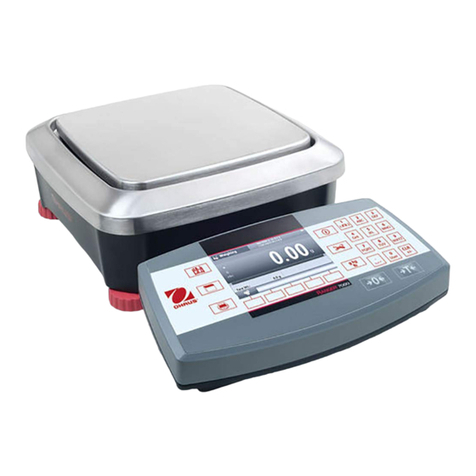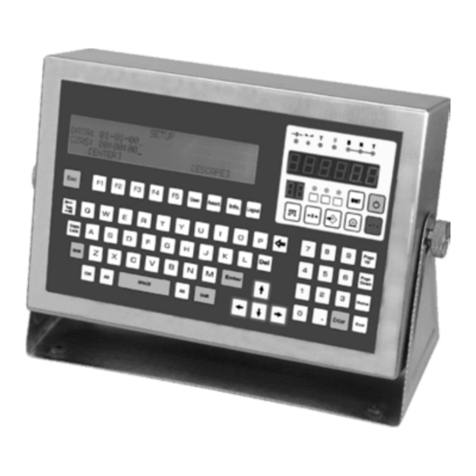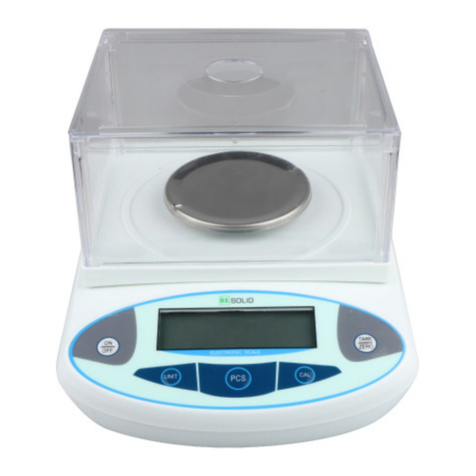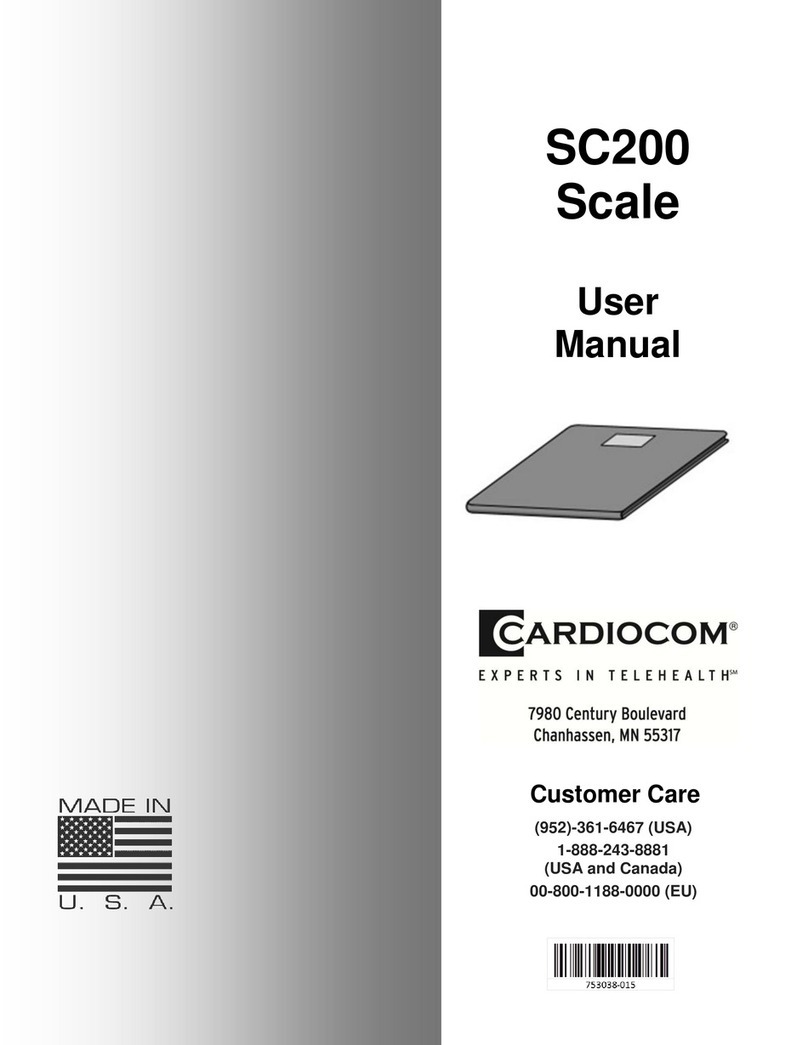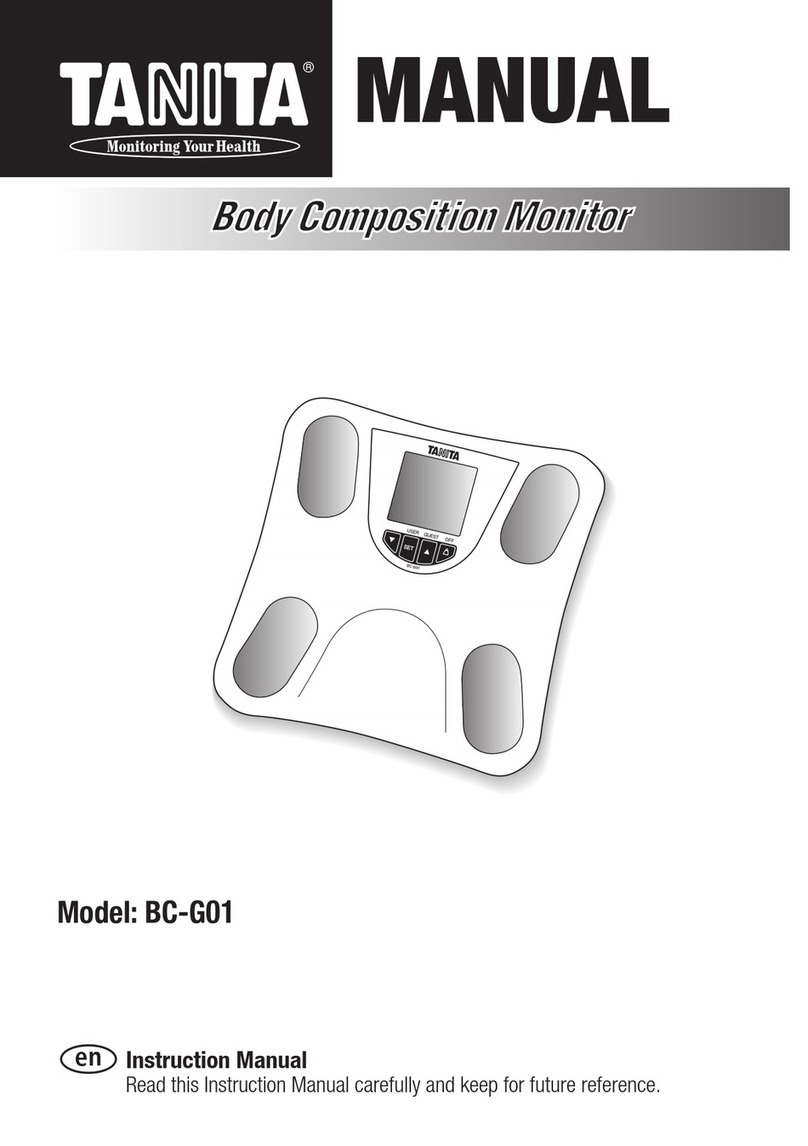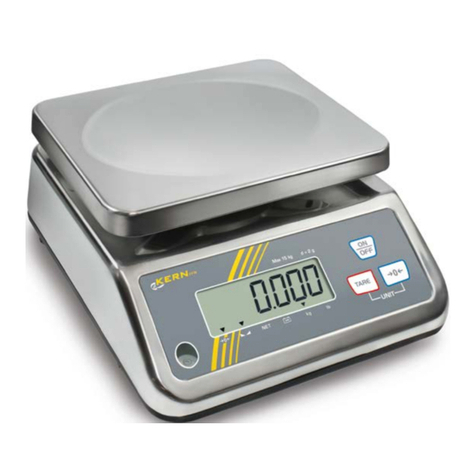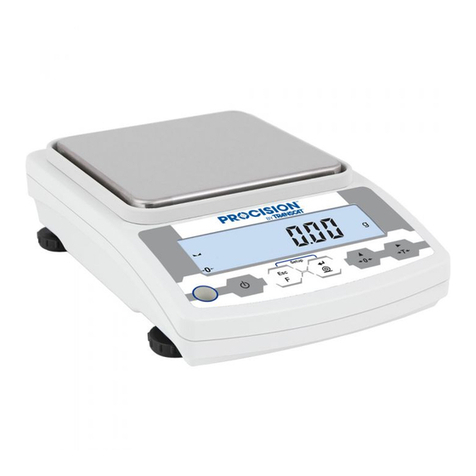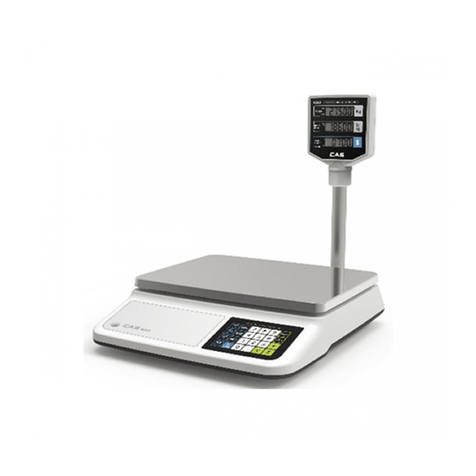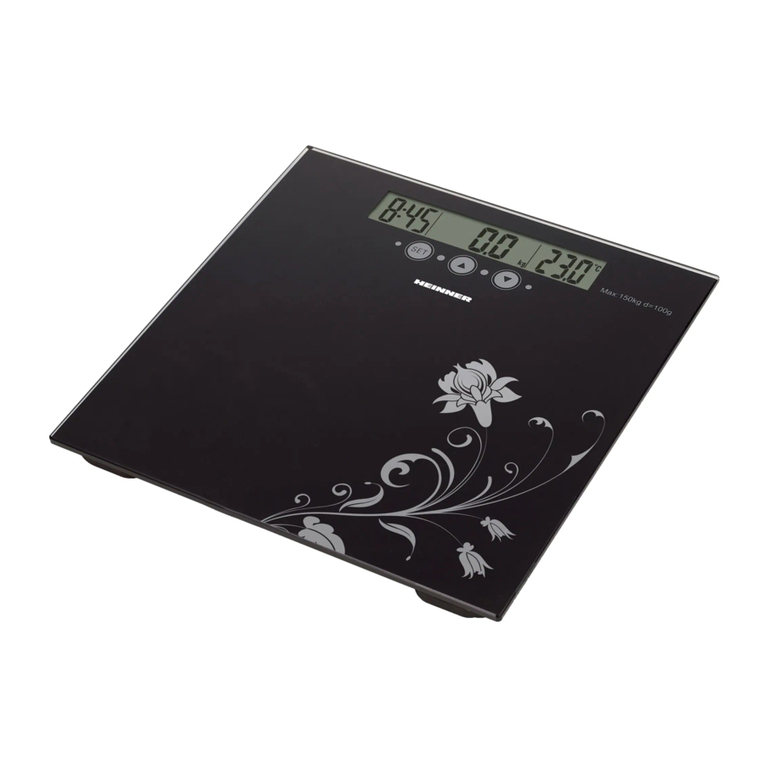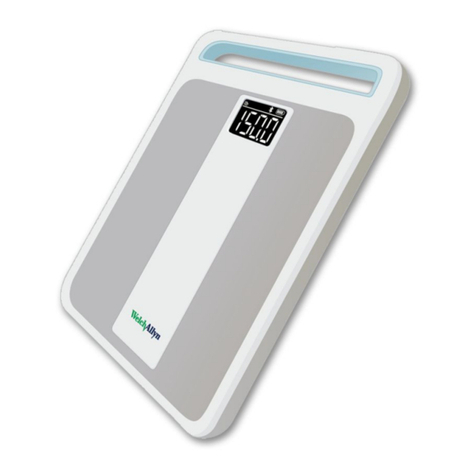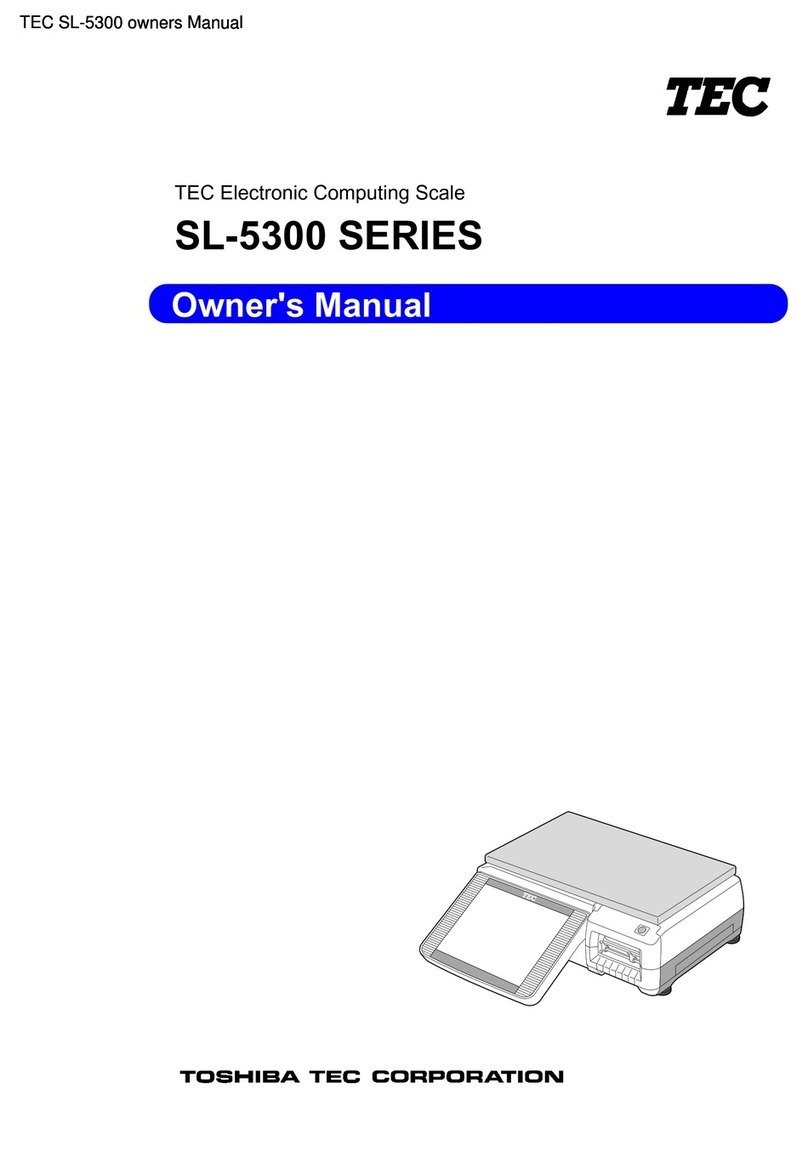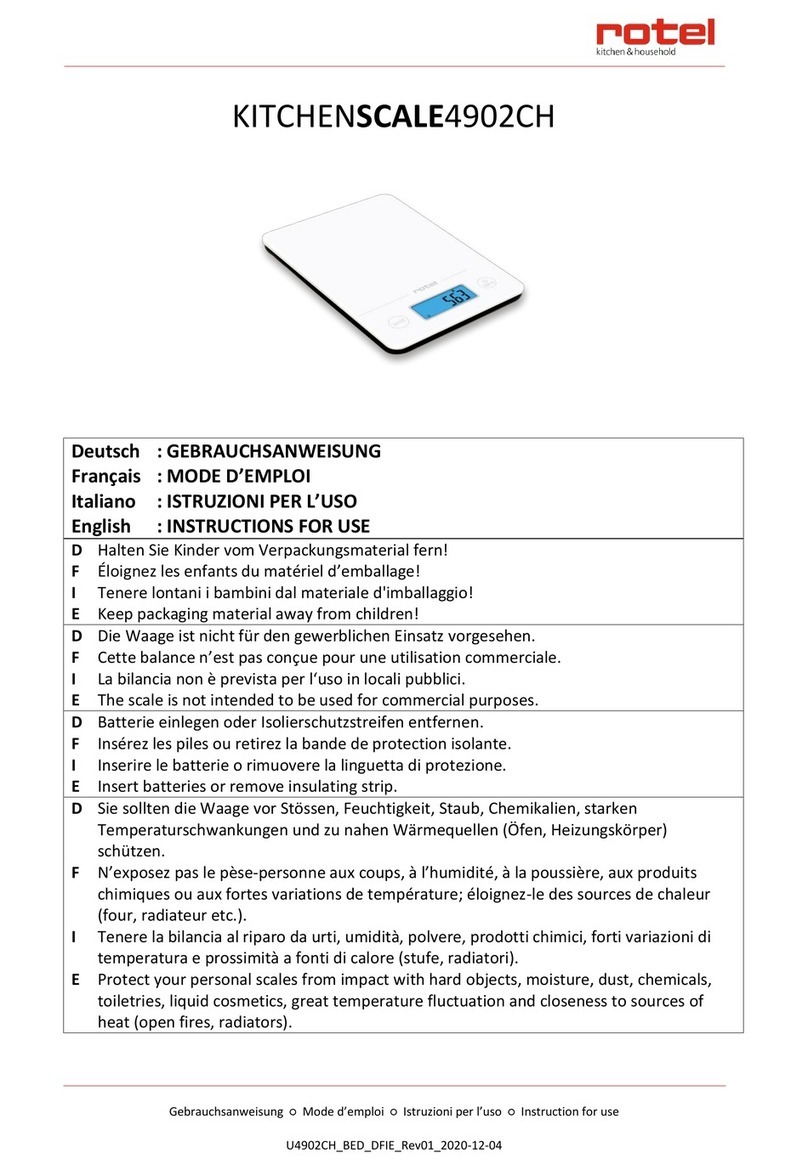Intercomp CS200 User manual

Page 1 of 15
CS200
Users Manual
Intercomp Co.
3839 County Road 116
Medina, M 55340 U.S.A.
(763)-476-2531
1-800-328-3336
Fax: 763-476-2613
www.intercompcompany.com
Manual #: 700182-H

C 200, Users
August, 2009
2
Table of Contents
INTRODUCTION .......................................................................................................................................................3
SPECIFICATIONS .....................................................................................................................................................3
CONTROLS .................................................................................................................................................................3
ELECTRICAL...............................................................................................................................................................3
PERFORMANCE ..........................................................................................................................................................3
ENVIRONMENTAL ......................................................................................................................................................3
PHYSICAL ..................................................................................................................................................................3
OPERATIONS............................................................................................................................................................. 4
OPERATING PRACTICES..............................................................................................................................................4
CONTROLS .................................................................................................................................................................5
On/Off ..................................................................................................................................................................5
ZERO....................................................................................................................................................................5
Backlight ..............................................................................................................................................................5
Units Switching (lb and kg)..................................................................................................................................6
OPTIONS MENU ..........................................................................................................................................................6
Peak hold ode....................................................................................................................................................6
Print .....................................................................................................................................................................6
Sa ple Rate .........................................................................................................................................................6
Sleep.....................................................................................................................................................................7
Auto-off ................................................................................................................................................................7
Serial output.........................................................................................................................................................7
Baud Rate.............................................................................................................................................................7
MAINTENANCE.........................................................................................................................................................8
PERIODIC INSPECTION................................................................................................................................................8
Service Categories ...............................................................................................................................................8
Inspection Require ents......................................................................................................................................8
Re oval fro Service Criteria.............................................................................................................................9
CALIBRATION.............................................................................................................................................................9
How to test the calibration...................................................................................................................................9
How to enter a nu ber.......................................................................................................................................10
Calibration blocking switch ...............................................................................................................................10
How to calibrate the CS200 ...............................................................................................................................11
ERROR MESSAGES ................................................................................................................................................ 14
CHANGING THE BATTERY ........................................................................................................................................14
HOW TO REACH INTERCOMP ...........................................................................................................................15
"This document is the property of Intercomp Co. It contains material and
information that is confidential and protected under federal and/or state trade
secret, unfair competition, and copyright law. Any reproduction, use or disclosure
without written permission from Intercomp Co. is prohibited".

C 200, Users
August, 2009
3
Introduction
This manual contains specifications and operation instructions for Intercomp's model
C 200 Crane cale.
Specifications
Controls
General: Zero, backlight, On/Off.
Display: 4 digit LCD.
Electrical
Batteries: 1 (9-volt) size disposable alkaline or rechargeable Nickel-
Cadmium cell.
Resolution: 14 bit A/D delivers over 16,000 internal counts..
Auto-Zero: Automatically zeros off errors of zero-load.
Battery life: 300 hours with an alkaline battery
20 hours with backlight on
Low battery indication:
Flashes “batt
battbatt
batt” when battery is running low; Turns off if
battery power is low enough to affect reliability.
Performance
Accuracy: ±0.1% of applied load or ± 1 display graduation, whichever is greater
Environmental
Humidity: 10 to 95% Non-Condensing.
Temperature:
Operating: -10 C to +50 C. / +15 F to +122 F.
torage: -40 C to +75 C. / -40 F to +170 F
Physical
Dimensions:
Height: 3.3" (6.2" with hooks) / 8.4cm (15.7cm with hooks)
Width: 4.4" / 11.2cm
Depth: 2.5" / 6.4cm
Weight: 1.1 lbs / 0.5 kg to 1.5 lbs / 0.7 kg depending on capacity

C 200, Users
August, 2009
4
Operations
Operating Practices
Warning: The crane scale will be operated by qualified designated persons, trainees
under the direct supervision of designated persons, maintenance and test personnel
when in performance of their assigned duties, or lifting device inspectors.
Warning: Do not exceed the rated load limit of the crane scale.
Warning: The crane scale shall be applied to the load in accordance with the
instruction manual.
Warning: Prior to lifting the operator shall make sure that all ropes or chains are not
kinked and if multiple lines are used they are not twisted around each other.
Warning: Ensure that the load is correctly distributed for crane scale use.
Warning: Ensure the temperature of the load does not exceed the maximum
temperature limits of the crane scale.
Warning: Ensure that swinging of the crane scale is minimized when positioning it over
the load.
Warning: Avoid any sudden acceleration of deceleration when moving the load.
Warning: Do not allow the crane scale or the lifter to come into contact with any
obstruction when moving the load.
Warning: Do not operate the crane scale if it has damaged, malfunctioning or missing
parts.
Warning: Do not lift people with the crane scale.
Warning: Do not lift suspended loads over people.
Warning: Do not use the crane scale to pull side loads or to slide loads unless
specifically authorized by a qualified person.
Warning: Do not leave suspended loads unattended.
Warning: Do not remove or obscure warning labels.
Warning: Do not operate the crane scale without having read and understood the
operating manual.

C 200, Users
August, 2009
5
Warning: tay clear of suspended loads.
Warning: Do not lift loads higher than necessary.
Warning: Do not make alterations or modifications to the crane scale.
Warning: Ensure all portions of the human body are kept clear of all device involved
with the rigging during the lift.
Controls
On/Off
Press this button to turn the C 200 on. The unit tests itself; when these tests
have completed successfully, the system begins weighing. Press this button
again to turn the unit off.
OTE: The scale will briefly display the firmware version when turning off.
ZERO
Tells the C 200 to display a zero weight. If you press ZERO with weight on the
pad, that weight becomes the zero condition for the scale. When this weight is
removed, a negative weight shows until the system is zeroed again.
OTE: if this negative number is too large to fit on the display, the scale will
display “dIS
dISdIS
dIS” until you press ZERO.
The scale contains a feature called Auto Zero Tracking (AZT), which corrects for
slight zero changes during normal operation. If small weights are added slowly,
the C 200 could zero them off.
Backlight
Press this key to toggle the backlight on and off.

C 200, Users
August, 2009
6
Units Switching (lb and kg)
The C 200 can toggle between lb and kg. To switch units simultaneously press
and hold the ZERO and backlight keys. After pressing and holding these keys
for a few seconds, the unit will momentarily display:
1) “kgS
kgSkgS
kgS”, if you have now switched to display in kgs.
2) “lbS
lbSlbS
lbS”, if you have now switched to display in lbs.
Options menu
The options menu allows access to the following functions: Peak mode, print, sample
rate, sleep mode, auto-off, serial output, and baud rate. To enter into the options menu,
simultaneously press the ZERO and backlight keys. The display will show “PEAk
PEAkPEAk
PEAk”.
Press the Zero or backlight keys to scroll through the menu options. To use or edit a
specific function, simultaneously press the ZERO and backlight keys. At this point you
will need to enter in a number:
How to enter a number:
Press the backlight key to increment the value of the blinking digit. To move the place
of the blinking digit, press the ZERO key. When the desired number is displayed,
simultaneously press the ZERO and backlight keys and release.
Peak hold mode
In this mode the unit will display only the highest force applied to the scale - until
you press the ZERO key.
To get into peak mode: Access the options menu. When the display shows
“PEAk
PEAkPEAk
PEAk”, simultaneously press the ZERO and backlight keys and release. The
tester will return to measurement mode and will display the peak force.
To return back to normal measurement mode, repeat the above procedure.
The unit will always turn on in “normal” operating mode.
Print
This feature is only applicable if you have the serial output version of the C 200.
To print: Access the options menu. Press ZERO until the display reads “Prnt
PrntPrnt
Prnt”.
The C 200 will print when you simultaneously press the ZERO and backlight
keys and release.
Sample Rate
The sample rate is the number of past readings that are averaged together to
make a reading. The default sample rate is 5.

C 200, Users
August, 2009
7
To adjust the sample rate: Access the options menu. Press ZERO until the
display reads “S rt
S rtS rt
S rt”. imultaneously press the ZERO and backlight keys and
release. Enter the sample rate. The display will momentarily display “SavE
SavESavE
SavE” and
return to normal mode.
Sleep
The sleep mode is designed to conserve battery life. The sleep mode time is
how long the scale's display will remain ON without any activity (a key being
pressed or a change in weight).
To adjust the sleep mode time: Access the options menu. Press ZERO until the
display reads “SLP
SLPSLP
SLP”. imultaneously press the ZERO and backlight keys and
release. Enter the sleep mode time (in minutes). To deactivate sleep, enter 0.
The maximum time is 180 minutes.
Auto-off
The auto off time is how long the scale will remain on without any activity (a key
being pressed or a change in weight).
To adjust the auto-off time: Access the options menu. Press ZERO until the
display reads “AOFF
AOFFAOFF
AOFF”. imultaneously press the ZERO and backlight keys and
release. Enter the auto-off time (in minutes). To deactivate auto-off, enter 0.
The maximum time is 180 minutes.
Serial output
This feature is only applicable if you have the serial output version of the C 200.
To turn on continuous serial output: Access the options menu. Press ZERO
until the display reads “SEr
SErSEr
SEr”. imultaneously press the ZERO and backlight keys
and release. Enter a “1” to activate serial output or “0” to deactivate.
Baud Rate
This feature is only applicable if you have the serial output version of the C 200.
When using serial output (this includes the print function), the baud rate must
match the peripheral device you are using.
To set the baud rate: Access the options menu. Press ZERO until the display
reads “bAud
bAudbAud
bAud”. imultaneously press the ZERO and backlight keys and release.
The following baud rates can be entered: 300, 600, 1200, 2400, 4800, 9600.
Default baud rate is 9600.

C 200, Users
August, 2009
8
Maintenance
Periodic Inspection
The crane scale and all associated adaptive devices require periodic inspection and
maintenance. The frequency and recording of the inspection requirements are found in
service categories below and are dependant on the type of service that the equipment
is used in as described below.
Service Categories
Normal ervice – Crane scale is operated at less than 85% of it’s capacity except for
isolated instances. Complete the frequent service inspection monthly and record the
periodic service inspection annually.
Heavy ervice – Crane scale is operated at 85% - 100% of it’s capacity as part of
normal usage. Complete the frequent service inspection weekly to monthly and record
the periodic service inspection semi-annually.
evere ervice – Crane scale is operated at 85% - 100% of it’s capacity and used in
environmental conditions that are unfavorable, harmful or detrimental to the use of the
crane scale. Complete the frequent service inspection daily to weekly and record the
periodic service inspection quarterly.
Inspection Requirements
Frequent Service Inspection (records not required)
A frequent visual inspection is completed at intervals indicated by the service category
above by the operator or designated person of the following.
1. Inspect for structural deformation, cracks or excessive wear of any part of the
crane scale or associated adaptive devices.
2. Inspect for loose or missing guards, fasteners, covers, stops, or nameplates.
3. Inspect all functional operating mechanisms and automatic hold and release
mechanisms for improper adjustments interfering with operation of the crane
scale or associated adaptive devices.
4. Inspect for distortion such as bending, twisting, or increased throat opening (if
applicable)
Periodic Service Inspection (records required)
A periodic visual inspection is completed at intervals indicated by the service category
above by the operator or designated person and documented to provide the basis for
continuing evaluation. The periodic inspection will cover areas in the frequent service
inspection above and the following.
1. Inspect for loose bolts or fasteners.
2. Inspect for cracked or worn gears, pulleys, sheaves, sprockets, bearings, chains,
and belts.

C 200, Users
August, 2009
9
3. Inspect for excessive wear of linkages and other mechanical parts.
4. Inspect for excessive wear at hoist hooking points and load support clevices or
pins.
5. Inspect for any visible bends or twists of all used rigging devices.
6. Inspect all latches and locks for proper operation (if applicable)
Removal from Service Criteria
Note: Replacement parts of any device or parts of any device used in any aspect of
rigging to lift a load shall be at least equal to the original manufacture’s specifications
Hooks
Hooks shall be removed from service if damage such as the following is found and shall
only be returned to service if a qualified person approves their continued use and
initiates corrective action.
1. Hooks show cracks, nicks, or gouges.
2. Hook has wear exceeding 10% of the original sectional dimension.
3. Hook has any visible bend or twist from the plane of the unbent hook.
4. Hook has an increase in throat opening of 5% not to exceed ¼ of an inch.
5. If self-locking hooks have the inability to lock.
6. A hook latch that is inoperable (if applicable)
Shackles
hackles shall be removed from service if damage such as the following is visible and
shall only be returned to service when approved by a qualified person.
1. If the manufacturers name or trademark and / or the rated load identification is
missing or illegible.
2. The device shows signs of heat damage including weld spatter or arc strikes.
3. The device shows excessive pitting or corrosion.
4. The device is bent, twisted, distorted, stretched, elongated, cracked, or has
broken load-bearing components.
5. The device has excessive nicks or gouges.
6. The device has a 10% reduction of the original or catalog dimension at any point
around the body or pin.
7. The device has incomplete pin engagement.
8. The device has excessive thread damage.
9. The device shows evidence of unauthorized welding.
10. Any other condition including visible damage that causes doubt to the continued
use of the shackle.
Calibration
How to test the calibration
This calibration procedure should be performed annually for normal operating
conditions. If the unit is dropped or damaged, or service has been performed on the
scale, use this calibration check. Recommend calibration points at 10% intervals from

C 200, Users
August, 2009
10
10% through 100% of the scales capacity.
Press the ON switch. The display does a lamp test; during this time the scale does a
quick check of itself. Then the weighing system starts weigh mode.
Intercomp recommends that you allow the electronics to operate for three minutes after
first turning power on. This allows the electronics to become stable for maximum
accuracy before you check the calibrations.
Make sure no weight is on the hook. Press the ZERO switch. The weight shown is zero.
Apply weights throughout the weighing range, and verify the correct weight is displayed
at each step. (+/- 0.1% of applied load or ±1 display graduation, whichever is greater)
If possible apply a weight of 105% of capacity, and verify the scale shows OVER on the
display.
Remove weights and verify the display returns to zero.
If there is a failure to meet any of the conditions above, please refer to the Calibration
Procedure.
When all the conditions above are correct, the scale is operational.
How to enter a number
During this routine you will be asked to enter numbers at many points. The scale will
show a number (originally all zeros) with a blinking digit. Press the ZERO key to
increase the value of the blinking digit. Press the BACKLIGHT key to move to other
digits. When you are finished entering the number press the ZERO and BACKLIGHT
keys together.
Three point span
This C 200 has a three point calibration feature which reduces the effects of non-
linearity in the load cells. This requires that you place three weights on the cell during
calibration. The first weight must be greater than zero, the second greater than the first,
and the final weight somewhere between the second and the capacity.
Calibration blocking switch
The calibration of the scale is protected from accidental change by a shunt placed on
pins 1 to 2 of CAL, located on the back of the circuit board. To allow calibration, the
shunt must be removed. When you are done calibrating, return the shunt to its original
location so that calibration is protected from change.

C 200, Users
August, 2009
11
How to calibrate the CS200
The following details the calibration procedure for the Intercomp C 200 crane scale.
There are four parameters that can be set before entering the actual calibration. When
changing a value, advance at least to “save
savesave
save” before turning off so that your changes are
saved.
Step Description ote Recommended
rd rt
rd rtrd rt
rd rt
Read rate 1 = 1 reads/sec
2 = 2 reads/sec
3 = 4 reads/sec
4 = 7 reads/sec
5 = 10 reads/sec
6 = 18 reads/sec
7 = 25 reads/sec
4
AZT
AZTAZT
AZT
Auto Zero Tracking 0 = disabled, 1,2,3 3
dely
delydely
dely
calibration delay 0 = no delay
1 = 7 second delay for cal
points
1
grad
gradgrad
grad
graduation 4 = 5 lb
5 = 2 lb
6 = 1 lb
7 = 0.5 lb
8 = 0.2 lb
9 = 0.1 lb
10 = 0.05 lb
11 = 0.02 lb
12 = 0.01 lb
cap
capcap
cap
capacity
save
cal
calcal
cal
calibration type 1 =1 point cal linear
0101 = 3 point cal
0101
LL00
LL00LL00
LL00
Zero read
LL01
LL01LL01
LL01
Cal load 1 Enter load 1
LL02
LL02LL02
LL02
Cal load 2 Enter load 2
LL03
LL03LL03
LL03
Cal load 3 Enter load 3
Start up.
1. Turn the power OFF.
2. Remove the calibration blocking shunt to allow entry into calibration mode.
3. Turn the power ON.
4. Wait for scale to warm up (3 minutes from power on).
5. Press ZERO and BACKLIGHT together and release to enter the calibration
mode.
The scale shows “rd rt
rd rtrd rt
rd rt”
. The read rate is the number of internal reads per
second the scale performs. A higher setting will result in a faster responding

C 200, Users
August, 2009
12
scale, but will also use the battery life more quickly. Press Zero until the desired
read rate is displayed. (see cal menu table above) Enter the read rate (1 to 7).
Press ZERO and BACKLIGHT together and release to enter the number
6. The scale shows “azt
aztazt
azt”. Press ZERO and BACKLIGHT together and release.
Enter (0) to turn the auto-zero tracking off, enter (1) to turn it on. When on, small
loads (+/- 3 divisions) will automatically be zeroed off after a few seconds. Press
ZERO and BACKLIGHT together and release to enter the number. Default = 1.
7. The scale shows “dELY
dELYdELY
dELY”. Press ZERO and BACKLIGHT together and release.
Enter (1) to turn the calibration delay on. If the delay is on: when the user
presses the keys to read a load point, there will be a 7 second delay until the
load point is actually read.
8. The scale shows “GrAd
GrAdGrAd
GrAd”. Press ZERO and BACKLIGHT together and release.
The scale shows the current graduation selection. Use the following table to
select a graduation value. Press ZERO and BACKLIGHT together and release to
enter the number.
etting
Count by in lb
Count by in kg
4 5 2
5 2 1
6 1 0.50
7 0.50 0.20
8 0.20 0.10
9 0.10 0.05
10 0.05 0.02
11 0.02 0.01
12 0.01 0.01
NOTE: The stated accuracy specifications are based on the graduation setting in
the table below. If the graduation setting is set other than the value in the table
below the accuracy specification remains with the graduation size listed below.
If your capacity is: Set your graduation to:
25 lb / 12.5 kg .01 lb / .01 kg (12)
50 lb / 25 kg .02 lb / .01 kg (11)
100 lb / 50 kg .05 lb / .02 kg (10)
250 lb / 125 kg .1 lb / 0.05 kg (9)
500 lb / 250 kg 0.2 lb / 0.1 kg (8)
9. The scale shows “CAP
CAPCAP
CAP”. Press ZERO and BACKLIGHT together and release.
Enter the scale's capacity in pounds.
At this point the gauge saves any changes that have been made

C 200, Users
August, 2009
13
Weight Calibration
10. The scale shows “CAL
CALCAL
CAL”. Press ZERO and backlight keys together and release.
The recommended calibration type is 3 point linear. Enter “0101”. Otherwise
enter “1” for a 1 point calibration.
11. The scale shows “LL00
LL00LL00
LL00”. With no weight on the pad, press ZERO and
BACKLIGHT together and release. This reads the pad zero.
12. The scale shows “LL01
LL01LL01
LL01”. Apply the first weight/force. Press the ZERO and
BACKLIGHT keys together and release. Then enter the value of the weight you
just applied. Press ZERO and BACKLIGHT together and release to enter this
number.
13. The scale shows “LL02
LL02LL02
LL02”. Apply the second weight. Press the ZERO and
BACKLIGHT keys together and release. Then enter the value of the weight you
just applied. Press ZERO and BACKLIGHT together and release to enter this
number.
14. The scale shows “LL03
LL03LL03
LL03”. Apply the third weight. Press the ZERO and
BACKLIGHT keys together and release. Then enter the value of the weight you
just applied. Press ZERO and BACKLIGHT together and release to enter this
number.
15. Return the calibration blocking shunt to it's original location to prevent accidental
entry into the calibration mode.
16. Verify the calibration.
17. Calibration complete.

C 200, Users
August, 2009
14
Error Messages
dISP
dISPdISP
dISP Display error, the scale is unable to display the number completely. If no
weight on the scale, press zero to return the weight reading to zero.
EEPE
EEPEEEPE
EEPE EEPROM error, the scale has had it's calibration corrupted or destroyed;
the scale will require calibration.
OE
OEOE
OE The scale is over capacity or outside the A/D converter range. Reduce the
load to the scale. If the C 200 continues to display “OE
OEOE
OE”, the problem
could be a bad load cell, bad load cell wiring, or a bad chip on the circuit
board.
OvEr
OvErOvEr
OvEr The C 200 is over capacity. Reduce the load on the pad.
BATT
BATTBATT
BATT Low battery, the unit requires a new battery. It will shut off if this message
is ignored for too long.
Changing the Battery
Turn the power off. lide the battery hatch down. Next, remove the battery from the
case and unsnap the used battery. nap in the new battery and replace the battery in
the case. Replace the cover.

C 200, Users
August, 2009
15
How to reach Intercomp
Things to know:
The service is for a C 200.
When did you purchase your C 200?
What is your serial number?
Whom did you purchase the C 200 through?
For Intercomp ervice call or fax:
FAX # (763)-476-2613
(763)-476-2531
1-800-328-3336
or fill out the ervice upport form at:
www.intercompcompany.com
Copyright Intercomp Company 2009
All rights reserved
Other manuals for CS200
1
Table of contents
Other Intercomp Scale manuals
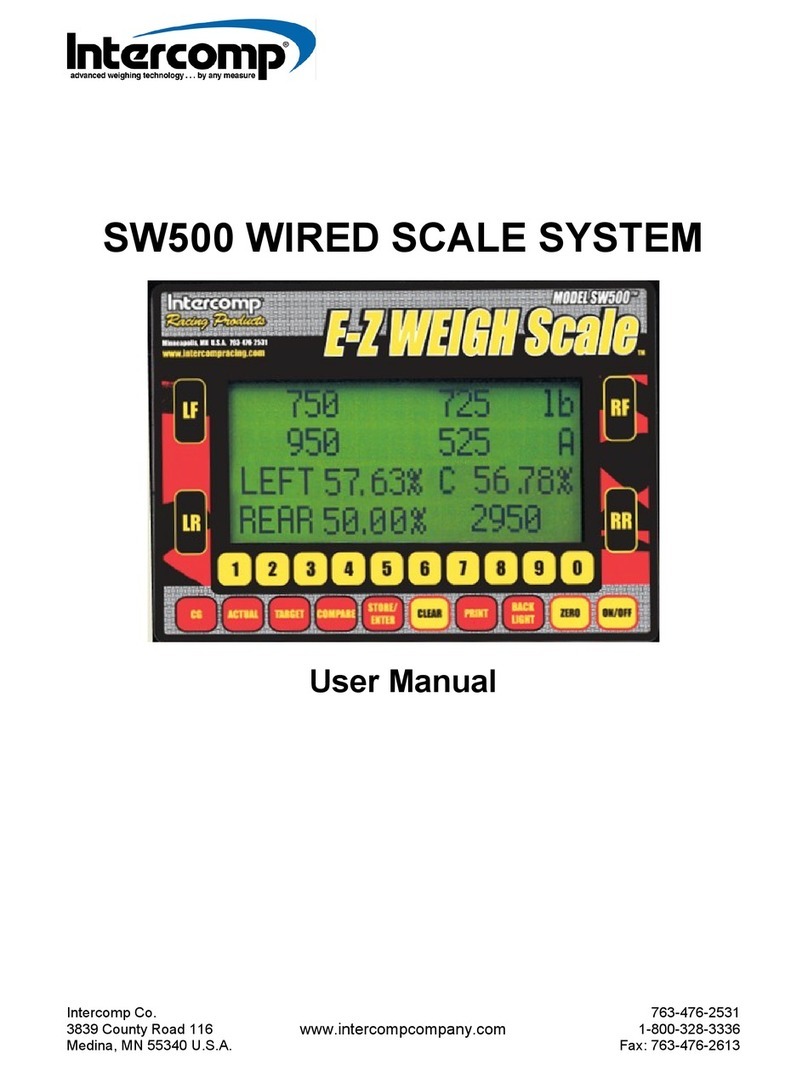
Intercomp
Intercomp SW500 User manual
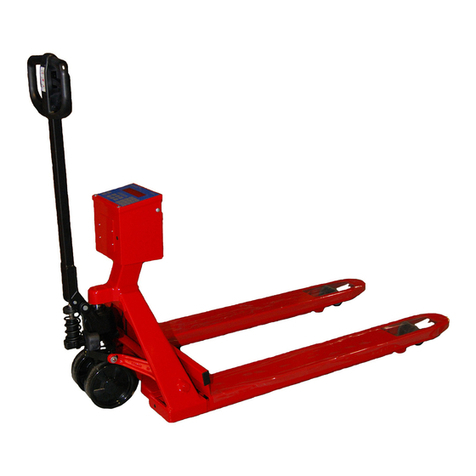
Intercomp
Intercomp PW800 User manual
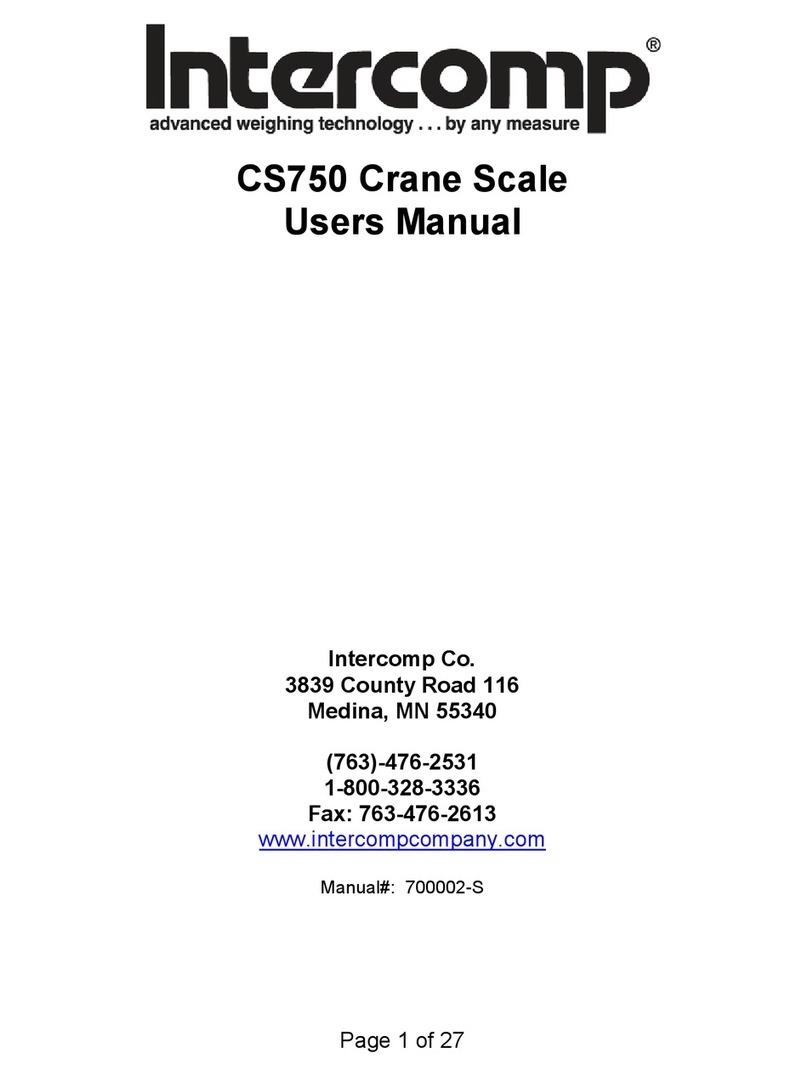
Intercomp
Intercomp CS750 User manual
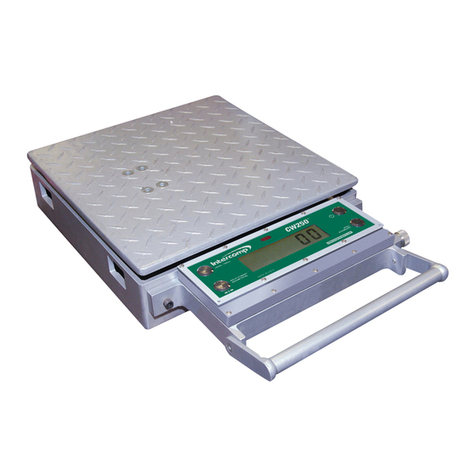
Intercomp
Intercomp CW250 User manual
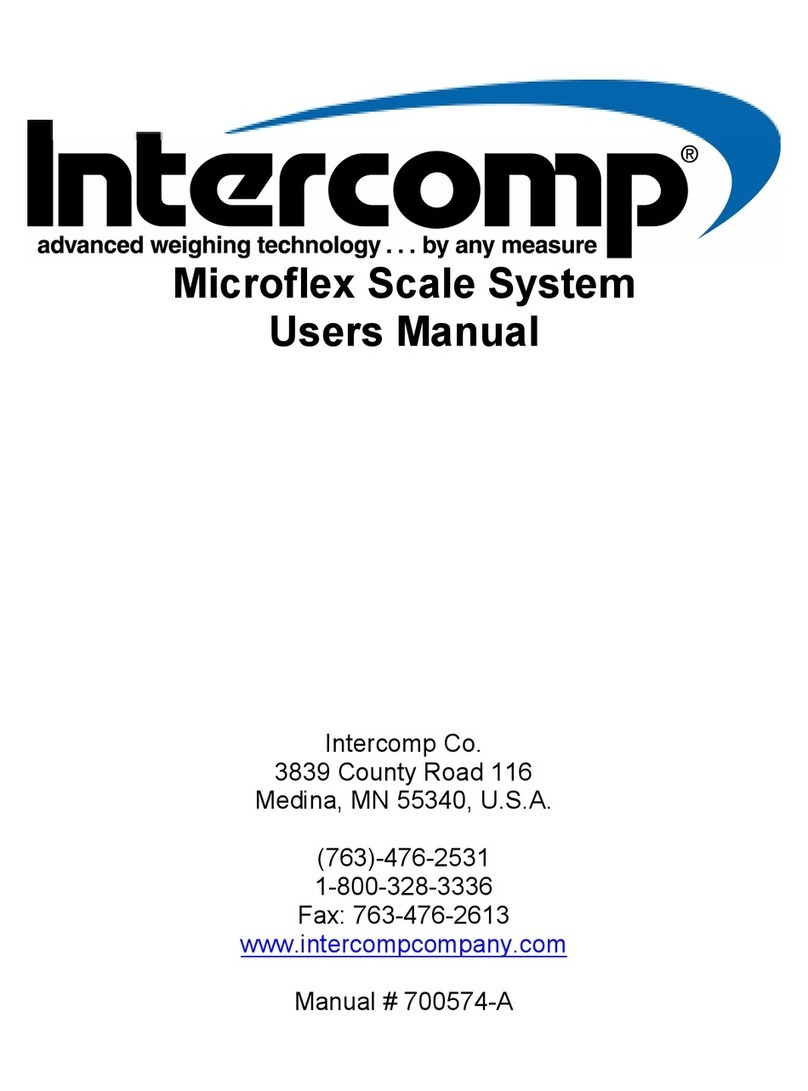
Intercomp
Intercomp Microflex User manual
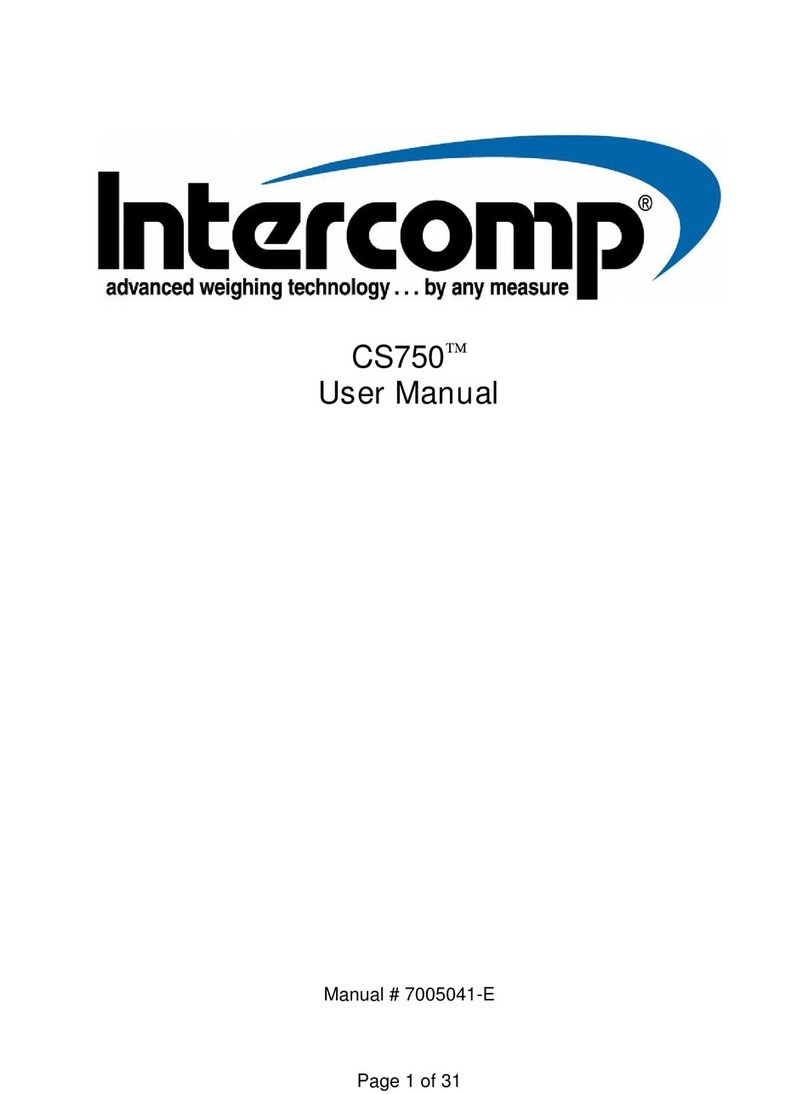
Intercomp
Intercomp CS750 User manual
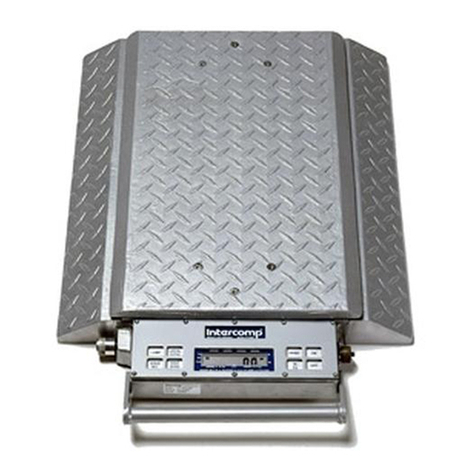
Intercomp
Intercomp PT300 User manual
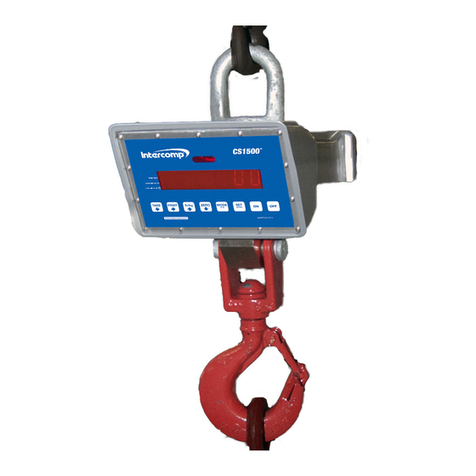
Intercomp
Intercomp CS1500 User manual
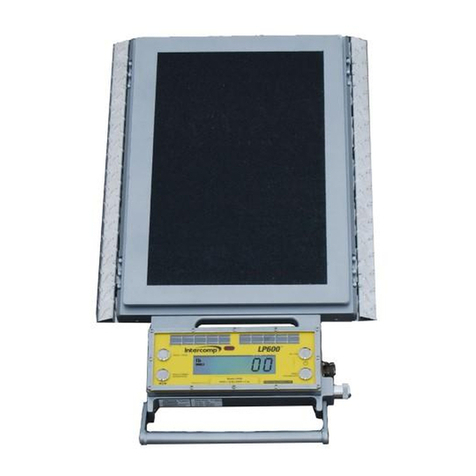
Intercomp
Intercomp LP600 User manual
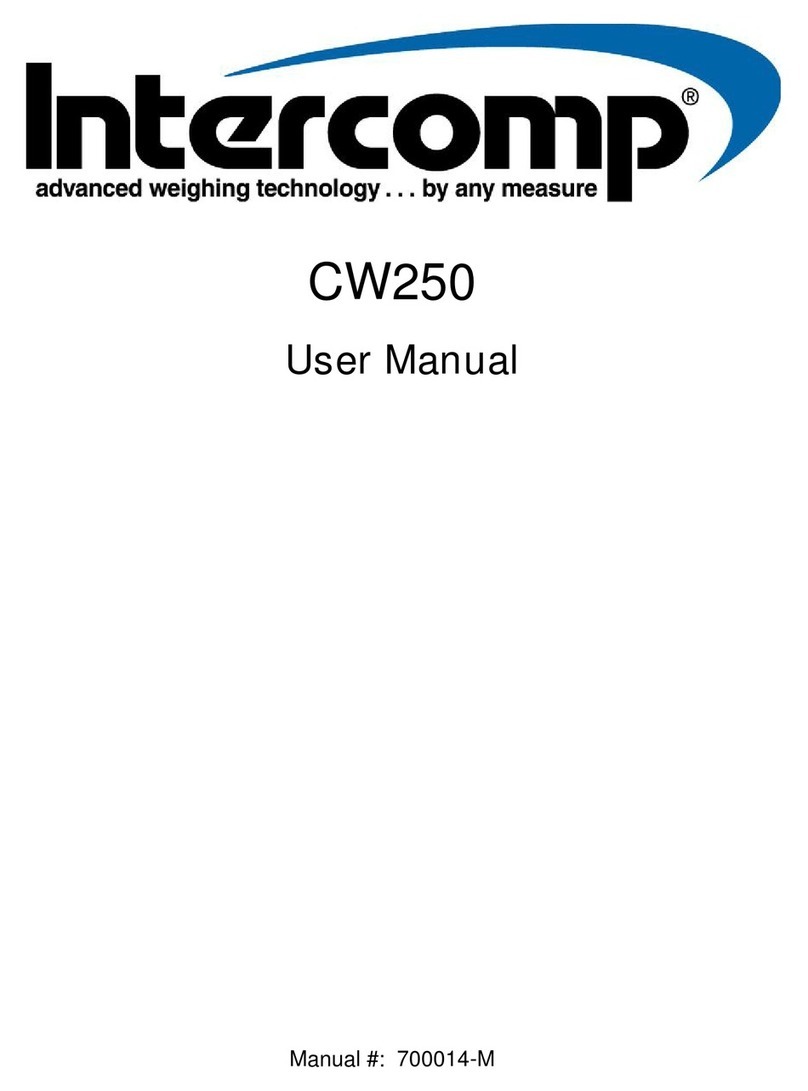
Intercomp
Intercomp CW250 User manual
